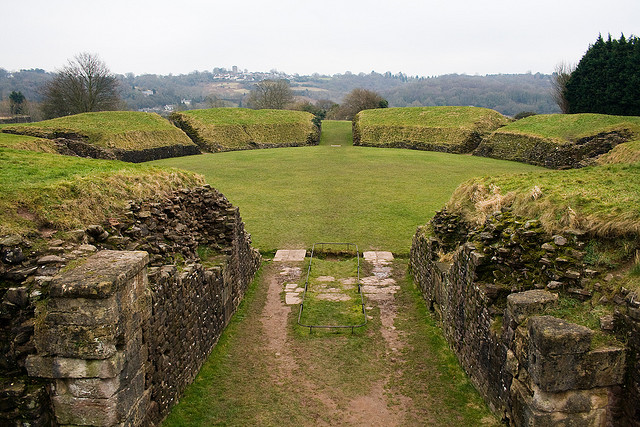“They came, they saw, they conquered”: The Roman legionary fortress at Caerleon
By Peter Guest
Y Cylchgrawn Hanes Digital History Magazine, Vol.9 (2015)

Introduction: Flavius Rufus was a Roman soldier in the Second Augustan Legion who had been given the task of building a warehouse in the fortress of Isca. The legion was preparing to move to northern Britain after the emperor Hadrian had ordered the construction of a new wall that would become the most northerly frontier of the mighty Roman Empire; a store-building was necessary because the legion needed somewhere secure to keep everything it could not take with it to the north. It turned out that it would be a long time before the legion returned to Isca and it may well be that once sent away to erect Hadrian’s Wall, Rufus never saw the fortress again.
Flavius Rufus must have served with distinction and he had been promoted to the highest rank possible for a normal legionary – the primus pilus, or ‘first rank’ centurion. Probably in his 40s at the time, the name ‘Flavius’ tells us that his family had been granted full Roman citizenship only a few years earlier by one of the Flavian emperors (Vespasian, Titus and Domitian). Perhaps his father had been a soldier in the Roman auxiliaries who, after serving a full twenty years himself, was discharged with an official diploma from the emperor that gave citizenship to his children. To be legally defined as a ‘Roman’ was an important privilege at that time as it meant his sons could join the legions instead of an auxiliary unit (with better pay and conditions), they could own property, vote and stand for political office, and have full rights of access to the laws of Rome. Flavius Rufus must have been in Isca only a few years after the local tribes in western Britain, following a seemingly endless war, had been finally subdued and ‘pacified’. This was the Wild West of the Empire where Romans and Britons must have lived uneasily alongside one another – sometimes peacefully but also, sometimes, in conflict.


 Flavius Rufus does not appear in any history books and until recently his existence had been long forgotten. We only know that a primus pilus with this name served in the Second Augustan Legion because James Goodsell, an archaeology undergraduate student, happened to be excavating the remains of a collapsed Roman building in Priory Field on the outskirts of Caerleon in southeast Wales. Caerleon has long been known to be the site of Isca and in the summer of 2008 a team of professional and student archaeologists from Cardiff University and UCL were in the middle of digging a large trench over a building that we had identified during a geophysical survey the previous year. Among the tumble of stones and decayed mortar, James found an unusually large square block of stone that he realised had a carved inscription on its outer face. This turned out to be a commemorative plaque that recorded the fact that Flavius Rufus, primus pilus of the Second Augustan Legion, built something. What Rufus was responsible for constructing is not stated, but it is likely that it was the building that James and his fellow archaeologists were digging – almost certainly the legion’s store.
Flavius Rufus does not appear in any history books and until recently his existence had been long forgotten. We only know that a primus pilus with this name served in the Second Augustan Legion because James Goodsell, an archaeology undergraduate student, happened to be excavating the remains of a collapsed Roman building in Priory Field on the outskirts of Caerleon in southeast Wales. Caerleon has long been known to be the site of Isca and in the summer of 2008 a team of professional and student archaeologists from Cardiff University and UCL were in the middle of digging a large trench over a building that we had identified during a geophysical survey the previous year. Among the tumble of stones and decayed mortar, James found an unusually large square block of stone that he realised had a carved inscription on its outer face. This turned out to be a commemorative plaque that recorded the fact that Flavius Rufus, primus pilus of the Second Augustan Legion, built something. What Rufus was responsible for constructing is not stated, but it is likely that it was the building that James and his fellow archaeologists were digging – almost certainly the legion’s store.
Click here to read this article from Aberystwyth University
Sponsored Content


“They came, they saw, they conquered”: The Roman legionary fortress at Caerleon
By Peter Guest
Y Cylchgrawn Hanes Digital History Magazine, Vol.9 (2015)
Introduction: Flavius Rufus was a Roman soldier in the Second Augustan Legion who had been given the task of building a warehouse in the fortress of Isca. The legion was preparing to move to northern Britain after the emperor Hadrian had ordered the construction of a new wall that would become the most northerly frontier of the mighty Roman Empire; a store-building was necessary because the legion needed somewhere secure to keep everything it could not take with it to the north. It turned out that it would be a long time before the legion returned to Isca and it may well be that once sent away to erect Hadrian’s Wall, Rufus never saw the fortress again.
Flavius Rufus must have served with distinction and he had been promoted to the highest rank possible for a normal legionary – the primus pilus, or ‘first rank’ centurion. Probably in his 40s at the time, the name ‘Flavius’ tells us that his family had been granted full Roman citizenship only a few years earlier by one of the Flavian emperors (Vespasian, Titus and Domitian). Perhaps his father had been a soldier in the Roman auxiliaries who, after serving a full twenty years himself, was discharged with an official diploma from the emperor that gave citizenship to his children. To be legally defined as a ‘Roman’ was an important privilege at that time as it meant his sons could join the legions instead of an auxiliary unit (with better pay and conditions), they could own property, vote and stand for political office, and have full rights of access to the laws of Rome. Flavius Rufus must have been in Isca only a few years after the local tribes in western Britain, following a seemingly endless war, had been finally subdued and ‘pacified’. This was the Wild West of the Empire where Romans and Britons must have lived uneasily alongside one another – sometimes peacefully but also, sometimes, in conflict.
Click here to read this article from Aberystwyth University
Sponsored Content